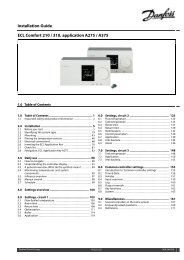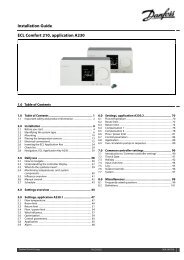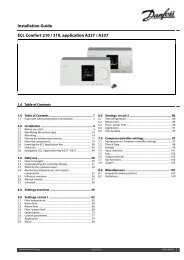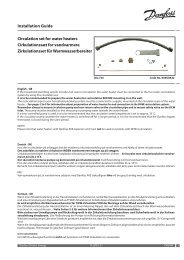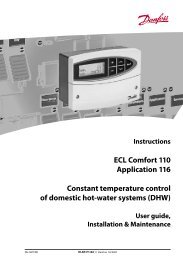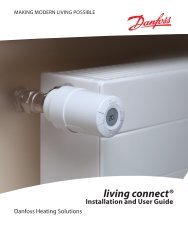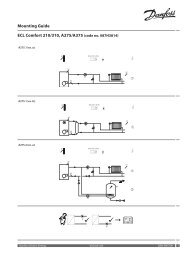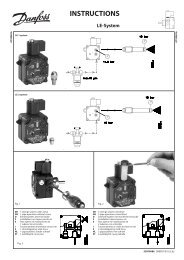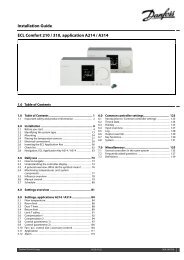ECL Comfort 210/310, A275/A375 Installation Guide - Danfoss ...
ECL Comfort 210/310, A275/A375 Installation Guide - Danfoss ...
ECL Comfort 210/310, A275/A375 Installation Guide - Danfoss ...
You also want an ePaper? Increase the reach of your titles
YUMPU automatically turns print PDFs into web optimized ePapers that Google loves.
<strong>Installation</strong> <strong>Guide</strong> <strong>ECL</strong> <strong>Comfort</strong> <strong>210</strong> / <strong>310</strong>, application <strong>A275</strong> / <strong>A375</strong><br />
High limit Y2 (return temp. limitation, high limit, Y-axis) 12034<br />
Circuit Setting range Factory setting<br />
2 10 ... 150 °C 60 °C<br />
Set the return temperature limitation referring to the outdoor temperature<br />
set in 'Low T out X2'.<br />
The corresponding X coordinate is set in 'Low T out X2'.<br />
Infl. - max. (return temp. limitation - max. influence) 12035<br />
Circuit Setting range Factory setting<br />
2 -9.9 ... 9.9 0.0<br />
Determines how much the desired flow temperature will be influenced if the<br />
return temperature is higher than the calculated limit.<br />
Influence higher than 0:<br />
The desired flow temperature is increased, when the return<br />
temperature gets higher than the calculated limit.<br />
Influence lower than 0:<br />
The desired flow temperature is decreased, when the return<br />
temperature gets higher than the calculated limit.<br />
Infl. - min. (return temp. limitation - min. influence) 12036<br />
Circuit Setting range Factory setting<br />
2 -9.9 ... 9.9 0.0<br />
Determines how much the desired flow temperature will be influenced if the<br />
return temperature is lower than the calculated limit.<br />
Influence higher than 0:<br />
The desired flow temperature is increased, when the return<br />
temperature gets below the calculated limit.<br />
Influence lower than 0:<br />
The desired flow temperature is decreased, when the return<br />
temperature gets below the calculated limit.<br />
Adapt. time (adaptation time) 12037<br />
Circuit Setting range Factory setting<br />
2 OFF / 1 ... 50 s 25 s<br />
Controls how fast the return temperature adapts to the desired return<br />
temperature limit (I control).<br />
OFF: The control function is not influenced by the ‘Adapt.<br />
time’.<br />
1: The desired temperature is adapted quickly.<br />
50: The desired temperature is adapted slowly.<br />
Example<br />
The return limit is active above 50 °C.<br />
The influence is set to -2.0.<br />
The actual return temperature is 2 degrees too high.<br />
Result:<br />
The desired flow temperature is changed by -2.0 x 2 = -4.0 degrees.<br />
Normally, this setting is lower than 0 in district heating systems to<br />
avoid a too high return temperature.<br />
Typically, this setting is 0 in boiler systems because a higher return<br />
temperature is acceptable (see also 'Infl. - min.').<br />
Example<br />
The return limit is active below 50 °C.<br />
The influence is set to -3.0.<br />
The actual return temperature is 2 degrees too low.<br />
Result:<br />
The desired flow temperature is changed by -3.0 x 2 = -6.0 degrees.<br />
Normally, this setting is 0 in district heating systems because a lower<br />
return temperature is acceptable.<br />
Typically, this setting is higher than 0 in boiler systems to avoid a too<br />
low return temperature (see also 'Infl. - max.').<br />
The adaptation function can correct the desired flow temperature<br />
with max. 8 K.<br />
130 DEN-SMT/DK VI.GU.L1.02 <strong>Danfoss</strong> District Energy



